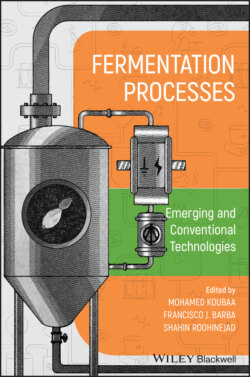Читать книгу Fermentation Processes: Emerging and Conventional Technologies - Группа авторов - Страница 16
1.2 Energetic Metabolism
ОглавлениеMicroorganisms need energy and carbon for their metabolism and are classified as autotrophs and heterotrophs depending on the sources of energy and nutrients (Misra 2011). There are only two sources of energy metabolizable by the cells: light energy captured during photosynthesis and energy from the oxidation of organic and inorganic molecules. Nevertheless, cells can be categorized into nutritional categories depending on how they meet these needs. In bioprocesses, three of these classes are potentially exploited on an industrial scale: phototrophs, chemolithotrophs, and chemoorganotrophs (Jurtshuk 1996).
Phototrophs use light as a source of energy and carbon dioxide (CO2) as a source of carbon. They include photosynthetic bacteria (cyanobacteria), algae, and green plants. Chemolithotrophs rely on electrons from reduced inorganic compounds, such as iron, nitrogen, or sulfur, as a source of energy (oxidation of the inorganic material) and CO2 as a carbon source. They include several bacterial species that are primarily used in environmental bioprocesses, particularly in aerobic wastewater treatment. The chemoorganotrophs use, as a source of energy, electrons from hydrogen atoms that are part of organic compounds (oxidation of organic matter), which also serve as a carbon source. They are the ones who enter the vast majority of bioprocesses, particularly in fermentation processes (bacteria, yeasts, and molds) and in animal cell cultures. The next sections will discuss the metabolism of this class of cells.
All living organisms need energy to grow and reproduce. In chemoorganotrophs, this energy is obtained during the degradation of organic compounds. Mainly, carbohydrates, lipids, and proteins are oxidized to release the chemical energy they contain. This energy will be then transferred to adenosine diphosphate (ADP) and inorganic phosphate (Pi) molecules before being stored in the form of adenosine triphosphate (ATP) (Figure 1.1). ADP and ATP correspond to molecules of adenosine monophosphate (AMP) plus one and two high‐energy phosphates (AMP ~ P and AMP ~ P ~ P, respectively). The energy is stored in these compounds as high‐energy phosphate bonds. All living cells must maintain steady‐state biochemical reactions for the formation and use of such high‐energy compounds.
Biochemical assimilation (anabolism) and dissimilation (catabolism) of nutrients by a chemoorganotroph are mediated by a network of enzymatic reactions perfectly synchronized and regulated. Anabolic pathways consist mainly of the reductive processes that lead to producing new cellular molecules, while catabolic pathways include the oxidative processes involved in removing electrons from substrates or intermediates that are used to generate energy.
Figure 1.1 Energy coupling and the role of ATP in microbial metabolism. ADP: adenosine diphosphate, ATP: adenosine triphosphate
